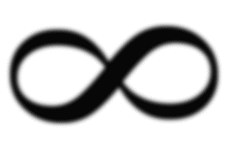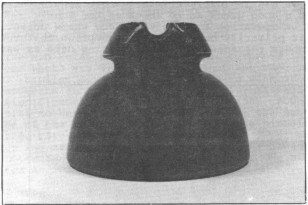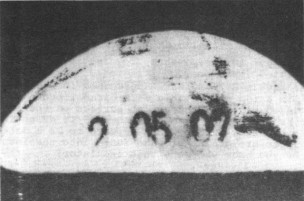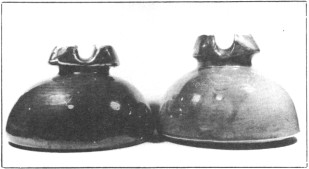Porcelain Insulator News
by Elton Gish, NIA #41
Reprinted from "Crown Jewels of the Wire", June 1985, page 16
Dear Elton,
I was cataloguing some new porcelain pieces recently for my collection and I
came across a weird marking arrangement that may be of interest.
The piece is a U-648 in yellowish brown with reddish brown mottling. It has
the normal VICTOR R= insulator logo, but then the worker went berserk. Around
the skirt, the word VICTOR is incuse stamped nine times with a tenth one in the
wire saddle. insulator logo, but then the worker went berserk. Around
the skirt, the word VICTOR is incuse stamped nine times with a tenth one in the
wire saddle.
Michael Guthrie

- - - - - - - - - - -
Dear Michael,
Berserk? Maybe, but that guy evidently had a lot of extra time. That could
explain why some units are found without a marking. At any rate, it is a very
unusual if not a unique piece and a prize for any collection.
Elton

Dear Elton,
I recently acquired three U-746 top rest "Redlands" insulators
similar to those mentioned on page 27 of the Sept. 1983 CJ issue. All three are
white but only two are marked. The incuse markings on the skirt are date numbers
1/8 of an inch high. One date is 5-27-03 and the other is 5-28-03. They were
used on incoming 11,500 volt feeders to transformers in a sub-station built in
the early 1900's for the then privately owned I.R.T. (Independent Rapid Transit)
subway system which is now part of New York City's Metropolitan Transit. The insulators were
still in service until they were removed in April 1984. Were these made by
Imperial Porcelain Works?
I also have a U-709A that I purchased in southern Maine. It is a top rest
with a dark caramel brown glaze, unglazed pin hole and a flat surface on the
inner skirt. There are incuse stamped numbers 3/16 of an inch high on the top
rest surface that appears to be a date: 2 05 07. There are grains of sand fused
into the incuse numbers. Do you know who made this insulator?
James Brogle, NIA *2706
- - - - - - - - - - -
Dear James,
The dated white U-746 is an Imperial as the small date is typical on their
units. Most white Imperials have dates in the years 1897, 1898 and 1899 with an
occasional 1900. Brown units have been reported with 1901 and 1904 dates. I have
seen neither a white nor a brown unit with a 1903 date. The 'Redlands"
style is fairly common, but is uncommon in white and scarce with this
combination of white and 1903 date.


I am glad that you Sent the U-709A (shown in the above two photos) as an
in-hand look is better than any photo. The glaze is identical to a similar unit
that I have which is a sim U-746 incuse marked on the top rest 2 11 07 and has
three unreadable letters 1/8 of an inch tall incuse marked midway down the
skirt. In the photo below, the sim U-746 is on the left and compared to a marked
U-746 New Lexington, 0. on the right.
At present, there is no definite way to determine which company made these
top rest dated (if we can assume the numbers are dates) insulators. However, I
feel that we can logically eliminate some manufacturers and hazard a good guess
as to which of the four companies in operation at that time made these units. My
guess is primarily based on the assumption that the incuse numbers represent the
manufacturing date as was the practice of Imperial and Fred Locke though their dating
methods were each
dissimilar and unlike these two units.

Imperial can be eliminated since their plant was destroyed by a fire 2-03-07
before the 2 05 07 (U-709A) and 2 11 07 (aim U-746) dates. It probably isn't
logical that they would have pre-dated any production. A number of things
suggest that 1904 was probably the last year that Imperial made pin types --
their datings, styles, etc.
New Lexington was in operation at this time (1903 to circa late 1910's). The
N.L. 1908 catalog shows three one-piece triple petticoat styles: Redland (U-746)
, No. 1 (U-?) and No. 2 (U-709A) . N.L. glazes are not singular and distinctive
however. Glaze colors have been found in black, mahogany, sandy brown, many
shades of tans and browns, greenish, white and even light blue and turquoise blue-green. In any event, one can not discount a certain specimen as being N.L.
or not just because of its glaze color.
Thomas did not catalog a U-709A or U-746 in their 1904 or 1907 catalogs but
do show a U-746 in 1912.
The 1906 Locke catalog does not show a U-709A or U-746. The 1913 catalog does
show these two styles; however, their U-709A is listed as weighing 3-5/8 lbs.
The N.L. No. 2 (U-709A) is listed at 3 lbs. and this is the weight of the
specimen in question.
The sim U-746 and the U-746 N.L. compared in the previous photo are different
though of the same basic style. Similar differences can be found with other
manufacturers in other styles due to many variables, most significantly, the
trimming operation. Both of the two units do have two things in common -- the
bottom surface of the inner skirt is flat and the pinhole is unglazed. Brown
Imperials have a rounded inner skirt surface and are glazed up to where the
threads start. Both Locke and Thomas units have rounded inner skirt surfaces and
glazed pinholes.
I hope that I did not bore you with all this logic gymnastics, but I would
put my money on New Lexington as the manufacturer of these two specimens. Again,
it is just a guess.
Elton
| 